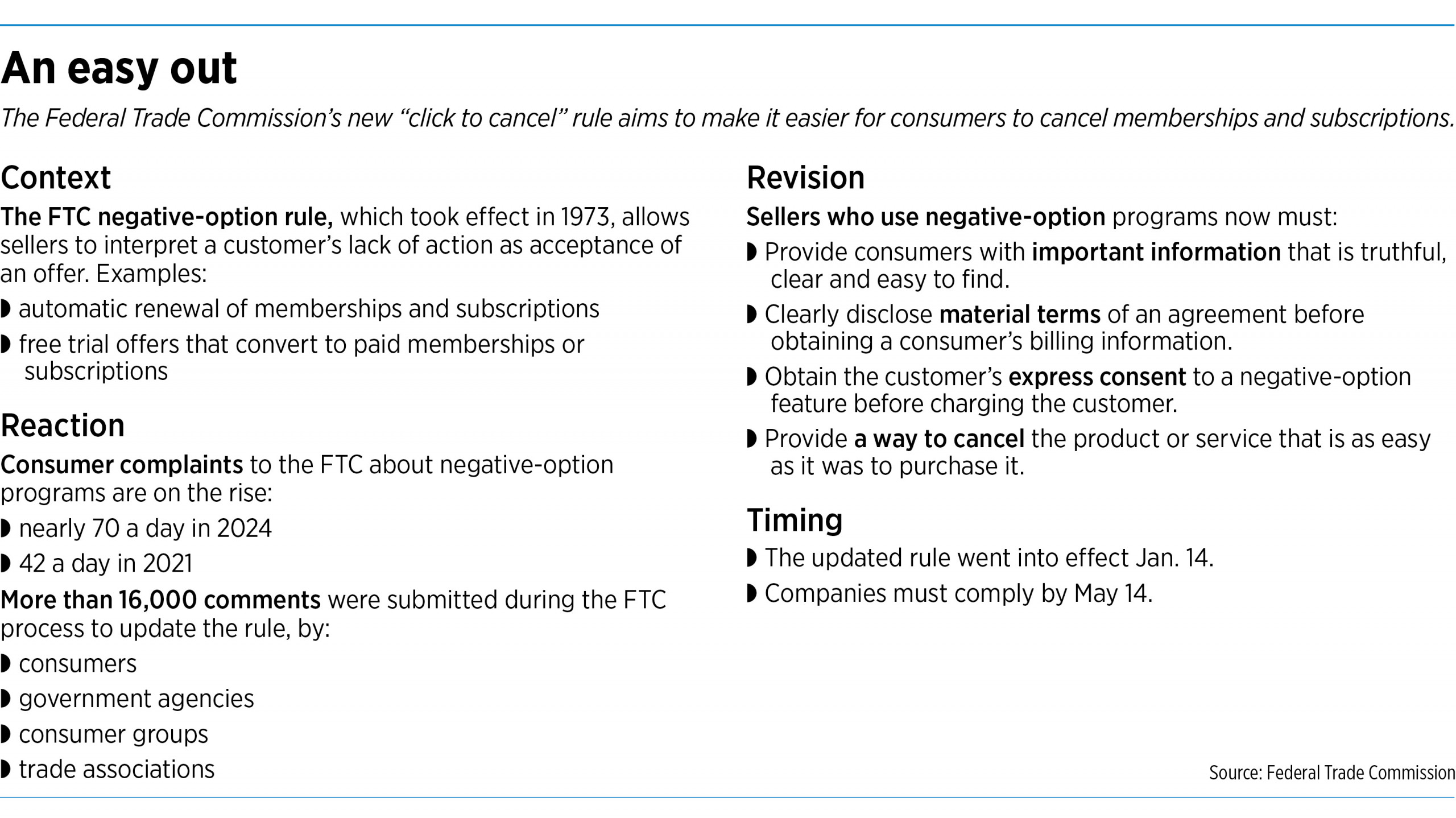Subscriber Benefit
As a subscriber you can listen to articles at work, in the car, or while you work out. Subscribe NowA new Federal Trade Commission rule known as “click-to-cancel” targets a common frustration: the difficulty of canceling an unwanted subscription.
That’s welcome news for consumers like Heidi Zurcher-Neely of Greenwood, who said she tried multiple times over two years before she was finally able to cancel a magazine subscription her 94-year-old mother had purchased.
“It shouldn’t be that hard,” Zurcher-Neely said. “It’s real easy to start something, but it’s almost impossible to stop it.”
Click-to-cancel means local businesses will also need to examine their policies and procedures to make sure they’re in compliance. The rule went into effect Jan. 14, although sellers have until May 14 to comply.
Zurcher-Neely’s ordeal began during a visit with her mother in Minnesota. Zurcher-Neely saw a stack of Time magazines whose mailing labels indicated that her mother had purchased a five-year subscription.
Realizing that her mother had likely intended to sign up for only one year and hadn’t realized the cost of a five-year subscription, Zurcher-Neely contacted the publication to ask that it cancel her mother’s subscription and refund the prorated cost. On subsequent visits every few months, Zurcher-Neely saw fresh magazines were still coming.
She said she tried at least four times, reaching out by mail, email and phone without success. “They continued to bill her over and over.”
Zurcher-Neely said she finally got the subscription canceled, but only after she threatened to take legal action. “I had tried to be very nice about it previously, and I was ignored.”
Zurcher-Neely was among the individuals, organizations and businesses that submitted more than 16,000 comments to the FTC during the public comments phase of the rule-change process. Zurcher-Neely wrote to express support for click-to-cancel, but other comments likely expressed a range of opinions and concerns, both in support of the rule and in opposition to it.
Click-to-cancel represents an update to the FTC’s negative-option rule, which went into effect in 1973. Under a negative-option program, a seller can interpret a consumer’s silence or failure to take action as acceptance of an offer. Common types of negative-option programs include subscriptions or memberships that automatically renew or free trial offers that convert to paid offers after an introductory period.
The click-to-cancel nickname refers to one of its key provisions: Sellers must now ensure that their customers can cancel a subscription or membership as easily as they signed up for it. In other words, if customers sign up online, they must also be able to cancel online—with the click of a button. If customers sign up in person, they must be able to cancel online or by phone.
Other provisions of the rule require sellers to clearly provide consumers with important information about the subscription upfront, so they know the deal’s terms before they hand over payment information.
Reaction
“I think it’s going to be great for consumers,” said Fishers attorney Robert E. Duff, whose law practice is called the Indiana Consumer Law Group. “There’s a lot more to the law than just ‘click-to-cancel.’”
Duff acknowledged that the fate of click-to-cancel is somewhat unknown under the Trump administration. The FTC approved the rule by a 3-2 vote, and one of those two dissenters, Andrew Ferguson, now leads the agency.
Legally speaking, it would be difficult to completely reverse the rule, Duff said, but the FTC could either modify the rule or simply not enforce it.
Regardless, Parker Busick, CEO of Bloomington-based software startup Soloist, said he is working to make sure the company’s smartphone app is in compliance with click-to-cancel when the app launches next month.
At the same time, he’s hoping click-to-cancel doesn’t hurt the company’s business model.
Soloist is building an app that solo musicians and music makers can use to record, save and share musical loops that can simulate the experience of playing music with others. The company will earn its revenue from app subscriptions.
Often, Busick said, paid apps offer a limited free trial in which users provide payment information upfront, with the charges starting after that trial period ends.
“That’s typically, I think, where companies were taking advantage of [customers],” he said. “They were too unclear on their messaging, and sort of tricking people into subscribing for things when they didn’t know they were subscribing to things.”
Busick said Soloist does intend to offer a free trial that consumers can access if they provide payment information upfront. After the trial ends, subscription fees will kick in. But, he said, the company will comply with click-to-cancel by making terms of the deal clear on the front end.
Busick said he generally favors click-to-cancel as a means of building transparency and customer trust. But he’s also worried that the ease of the new rule might encourage customers to game the system by signing up for a free trial, then canceling it before the first payment is due. “That’s my main fear as a startup.”
If cancellation rates are higher than expected, Busick said, he plans to revisit Soloist’s free-trial policy, perhaps shortening the trial period or eliminating that option altogether.
Not a problem
Some local companies say they don’t foresee having to make any changes to their current practices under click-to-cancel.
Jane Levy is co-founder and co-CEO of Indianapolis-based health-tech startup Plan Forward LLC, whose software platform allows dental practices to create and manage membership plans for their uninsured patients. The membership plans are structured as negative-option programs; a patient’s membership renews automatically unless the patient calls or emails the dental practice to cancel it.
Levy said she believes Plan Forward is already in compliance with the click-to-cancel rule and will not have to adjust its policies and procedures.
As the Plan Forward platform is structured, dental patients cannot enroll for memberships online—they must do so in person at their dentist’s office. Should patients decide to unsubscribe, Levy said, they can do so by calling or providing written notice to the dental practice. Written notice can be an email.
“We have always provided [patients] with all the important information that they need before the practice gets the billing information and charges them,” Levy said.
Levy said she understands the reasoning behind the click-to-cancel rule and has experienced her own frustrations with trying to cancel personal subscriptions. At times, she’s resorted to using OpenAI’s ChatGPT chatbot, asking for step-by-step instructions on how to cancel a particular subscription. (The chatbot usually does supply the correct instructions, Levy said.)
Indianapolis-based Ash & Elm Cider Co. makes a small percentage of its revenue from its cider club, in which customers can sign up to receive cider shipments on a monthly or quarterly basis. Once customers sign up, they continue to receive cider until they indicate otherwise.
Andrea Homoya, who co-founded Ash & Elm with her husband in 2016, said the company found that some customers were having trouble figuring out how to cancel their club memberships—so it added more information to its website.
Customers who sign up for cider club can choose monthly or quarterly deliveries. Before each delivery, customers receive an e-mail with information about what products they will be receiving. They can update their address and payment information at that time or cancel their subscription.
“I don’t want people to be paying for anything they don’t want anymore,” Homoya said.
Andre Ramsey, co-founder and CEO of Zionsville-based CoinCoffee Inc., said his company’s coffee subscription program is already compliant with the click-to-cancel requirement.
“Since we’re already set up to comply with these guidelines, we don’t anticipate major changes,” Ramsey said via email. “We do hope this rule helps weed out bad actors using problematic processes to keep subscriptions going.”
Attorney Dana Sarros, a Chicago-based partner at Indianapolis-based Barnes & Thornburg LLP, said she’s fielded many queries from her business clients about click-to-cancel. “This is actually a huge topic of conversation with businesses.”
Companies don’t need to go to the extreme of putting an eye-catching “CANCEL” button on their home page, Sarros said. But they should take a hard look at their existing enrollment and cancellation procedures from a customer’s point of view.
“What’s the difference between how easy it is to sign up and how easy it is to get out? The closer those two processes look, the better,” she said.
Another thing to consider, Sarros added, is that most companies fall into a gray area on this topic—their processes are probably neither totally compliant with click-to-cancel, nor totally noncompliant. In other words, most companies will find some room for improvement.
She advised consulting with an attorney or other expert who can provide guidance on the new rule. “The real takeaway is, don’t ignore it. Don’t assume.”•
Please enable JavaScript to view this content.





